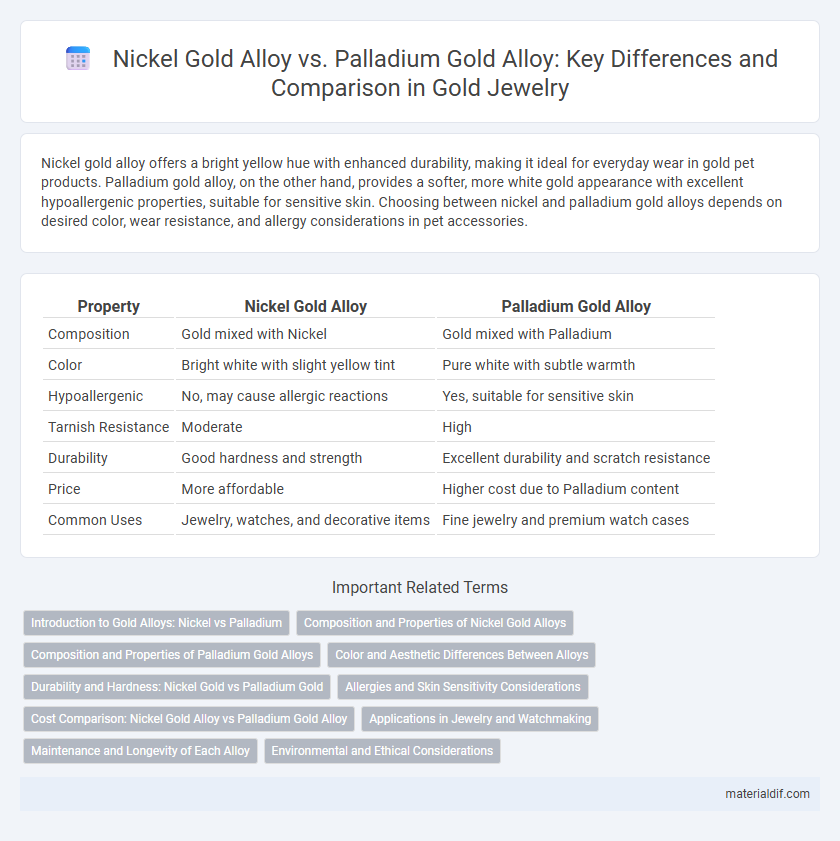Nickel gold alloy offers a bright yellow hue with enhanced durability, making it ideal for everyday wear in gold pet products. Palladium gold alloy, on the other hand, provides a softer, more white gold appearance with excellent hypoallergenic properties, suitable for sensitive skin. Choosing between nickel and palladium gold alloys depends on desired color, wear resistance, and allergy considerations in pet accessories.
Table of Comparison
| Property | Nickel Gold Alloy | Palladium Gold Alloy |
|---|---|---|
| Composition | Gold mixed with Nickel | Gold mixed with Palladium |
| Color | Bright white with slight yellow tint | Pure white with subtle warmth |
| Hypoallergenic | No, may cause allergic reactions | Yes, suitable for sensitive skin |
| Tarnish Resistance | Moderate | High |
| Durability | Good hardness and strength | Excellent durability and scratch resistance |
| Price | More affordable | Higher cost due to Palladium content |
| Common Uses | Jewelry, watches, and decorative items | Fine jewelry and premium watch cases |
Introduction to Gold Alloys: Nickel vs Palladium
Nickel gold alloys offer enhanced hardness and durability, making them ideal for jewelry that resists scratches and maintains its shape over time. Palladium gold alloys provide superior tarnish resistance and a naturally white sheen without the need for rhodium plating, often preferred for its hypoallergenic properties. Both alloys influence the color, strength, and price of gold jewelry, with nickel alloys generally being more cost-effective and palladium alloys favored for their premium quality and skin-friendly characteristics.
Composition and Properties of Nickel Gold Alloys
Nickel gold alloys primarily consist of gold combined with 5-15% nickel, enhancing hardness and corrosion resistance compared to pure gold. This alloy exhibits a pale yellow to white color, offering increased durability suitable for jewelry and industrial applications. Nickel's presence improves tensile strength and wear resistance but may cause allergic reactions in sensitive individuals, distinguishing it from palladium gold alloys known for higher hypoallergenic properties.
Composition and Properties of Palladium Gold Alloys
Palladium gold alloys typically consist of 10-25% palladium mixed with gold, enhancing whiteness and corrosion resistance while maintaining excellent ductility and hardness. Compared to nickel gold alloys, palladium gold alloys offer superior hypoallergenic properties and improved tarnish resistance due to the inert nature of palladium. The precise balance in palladium gold alloys results in metals used extensively in fine jewelry and dental applications, providing durability without compromising aesthetic appeal.
Color and Aesthetic Differences Between Alloys
Nickel gold alloy exhibits a warm, yellow hue with a subtle brightness, making it popular for traditional gold jewelry that demands durability and a classic look. Palladium gold alloy, by contrast, offers a whiter, more silvery tone that enhances the brilliance and modern appeal of white gold pieces. The choice between nickel and palladium alloys significantly influences the jewelry's color stability, wear resistance, and overall aesthetic, with palladium providing a naturally whiter base requiring less rhodium plating.
Durability and Hardness: Nickel Gold vs Palladium Gold
Nickel gold alloy exhibits superior hardness and durability compared to palladium gold alloy, making it ideal for jewelry and industrial applications requiring resistance to wear and deformation. Palladium gold alloy, while softer, offers excellent corrosion resistance and hypoallergenic properties, but it may scratch and bend more easily under stress. The choice between nickel gold and palladium gold alloys depends on balancing hardness for longevity with the desired level of comfort and skin sensitivity.
Allergies and Skin Sensitivity Considerations
Nickel gold alloy often triggers allergic reactions and skin sensitivity due to nickel content, affecting individuals with nickel allergies. Palladium gold alloy is hypoallergenic, making it a preferable option for people prone to skin irritation or metal allergies. Choosing palladium gold reduces the risk of dermatitis commonly associated with nickel exposure in jewelry.
Cost Comparison: Nickel Gold Alloy vs Palladium Gold Alloy
Nickel gold alloys typically exhibit lower costs compared to palladium gold alloys due to the abundance and lower market price of nickel versus palladium. The price difference affects not only raw material expenses but also manufacturing costs in jewelry and electronics applications. Consumers and manufacturers often prefer nickel gold alloys when budget constraints are critical, while palladium gold alloys are chosen for their hypoallergenic properties despite higher costs.
Applications in Jewelry and Watchmaking
Nickel gold alloy offers excellent hardness and corrosion resistance, making it ideal for durable and scratch-resistant jewelry and watch components. Palladium gold alloy, prized for its hypoallergenic properties and bright white sheen, is favored in luxury watchmaking and fine jewelry where skin sensitivity and aesthetic appeal are paramount. Both alloys enhance gold's versatility, with nickel gold suited for robust everyday wear and palladium gold preferred for premium, delicate designs.
Maintenance and Longevity of Each Alloy
Nickel gold alloy offers superior hardness and resistance to wear, resulting in lower maintenance requirements and extended durability compared to palladium gold alloy. Palladium gold alloy, while slightly softer, provides excellent corrosion resistance and maintains its shine longer with mild care but may require more frequent polishing to prevent surface dulling. Overall, nickel gold alloys excel in high-wear applications due to their longevity, whereas palladium gold alloys are preferred for their hypoallergenic properties and moderate maintenance needs.
Environmental and Ethical Considerations
Nickel gold alloy involves nickel, which can cause allergic reactions and raises concerns due to mining practices linked to environmental degradation and social issues in nickel-producing regions. Palladium gold alloy, while generally more expensive, is favored for its lower allergenic potential and often sourced from mines adhering to stricter environmental and ethical standards. Choosing palladium gold alloy supports more sustainable and responsible mining practices, minimizing ecological impact and promoting fair labor conditions.
Nickel Gold Alloy vs Palladium Gold Alloy Infographic

 materialdif.com
materialdif.com